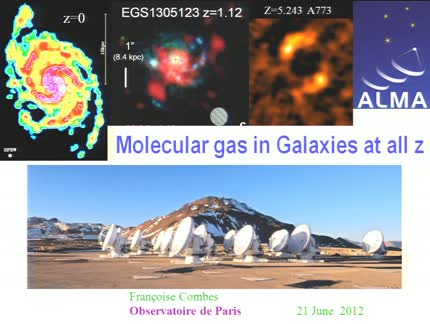Found 4 talks width keyword molecular clouds

Abstract
Gas kinematics on the scales of Giant Molecular Clouds (GMCs) are essential for probing the framework that links the large-scale organization of interstellar gas to cloud formation and subsequent star formation. I will present an overview of results from the PdBI Arcsecond Whirlpool Survey (PAWS, PI: E. Schinnerer), which has mapped CO(1-0) emission over 9 kpc in the nearby grand-design spiral galaxy M51 at 40 pc resolution, and is sensitive to giant molecular clouds (GMCs) with masses above 10^5 Msun. This unprecedented view challenges the conventional picture of how molecular gas is structured and organized in galaxies: clouds are not ‘universal’, but respond to their environment, resulting in a diversity of cloud properties that not only depend on (dynamical) environment but also vary from galaxy to galaxy. I will discuss how this sensitivity to environment emerges, in consideration of the stability of M51’s GMCs (including the effects of pressure, shear, turbulence) and our view of non-circular motions in the gas disk. As a result of the strong streaming motions that arise due to departures from axisymmetry in the gravitational potential (i.e. the nuclear bar and spiral arms), embedded clouds feel a reduced surface pressure, which can prevent collapse. This dynamical pressure naturally leads to changes in the efficiency of star formation and hence gas depletion time along the spiral arms. I will show that local reductions to cloud surface pressure in M51 dominate over shear and star formation feedback-driven turbulence in determining the observed radial variation the depletion time. I will also describe how incorporating a dynamical pressure term to the canonical free-fall time produces a single star formation law that can be applied to all star-forming regions and galaxies, across cosmic time.

Abstract
I will review some recent results about the molecular content of galaxies and its dynamics, obtained from CO lines, dense tracers (HCN,HCO+), or the dust continuum emission. New data to constrain the conversion factor XCO will be discussed. The molecular surface density is essential to determine the star formation efficiency in galaxies, and the resolved Kennicutt-Schmidt law will be presented as a function of surface density and galaxy type. Large progress has been made on galaxy at moderate and high redshifts, allowing to interprete the star formation history and star formation efficiency as a function of gas content, or galaxy evolution. In massive galaxies, the gas fraction was higher in the past, and galaxy disks were more unstable and more turbulent. ALMA observations will allow the study of more normal galaxies at high z with higher spatial resolution and sensitivity.

Abstract
In this talk I consider two questions. First, I investigate the formation of molecular clouds from diffuse interstellar gas. It has been argued that the midplane pressure controls the fraction of molecular hydrogen present, and thus the star formation rate. Alternatively, I and others have suggested that the gravitational instability of the disk controls both. I present numerical results demonstrating that the observed correlations between midplane pressure, molecular hydrogen fraction, and star formation rate can be explained within the gravitational instability picture. Second, I discuss how ionization affects the formation of massive stars. Although most distinctive observables of massive stars can be traced back to their ionizing radiation, it does not appear to have a strong effect on their actual formation. Rather, I present simulations suggesting that stars only ionize large volumes after their accretion has already been throttled by gravitational fragmentation in the accretion flow. At the same time these models can explain many aspects of the observations of ultracompact H II regions.

Abstract
The properties of molecular clouds associated with 10 H II regions were studied using CO observations. We identified 142 dense clumps within our sample and measured and calculated physical properties of the clumps such as size, excitation temperature, line widths, density and mass. We found that our sources are divided into two categories: those that show a size-line width relation ("type I") and those which do not show any relation ("type II"). Type II sources have larger line widths in general. Investigating the relation between the line width and other parameters shows that while the MLTE (Local Thermodynamic Equilibrium mass) increases with ΔV (line width) for both 12CO(2-1) and 13CO(2-1) lines in type I sources, no relation was found for type II sources. No relation between column density and line width was found for either category. We also investigated how the characteristics of the clumps vary with distance from the HII region. We found no relation between mass distribution of the clumps and distance from the ionization front, but a weak decrease of the excitation temperature with increasing distance from the ionized gas. Only the projected distance is measured in our study which is equal or smaller than the true value. Therefore we compared the results by a Monte Carlo simulation of a central heating source and found that for small distances the relation is very scattered, which is consistent with our results. No relation was found between line width and distance from the H II region which probably indicates that the internal dynamics of the clumps is not affected by the ionized gas. Internal sources of turbulence, such as outflows and stellar winds from young proto-stars may have a more important role.« Newer Older »
Upcoming talks
- TODAY: EMO-1: Construyendo un observatorio caseroEnol Matilla BlancoFriday April 19, 2024 - 10:30 GMT+1 (Aula)
- Classical Be stars - Constraining binary interaction physics in massive starsDr. Julia BodensteinerThursday April 25, 2024 - 10:30 GMT+1 (Aula)








